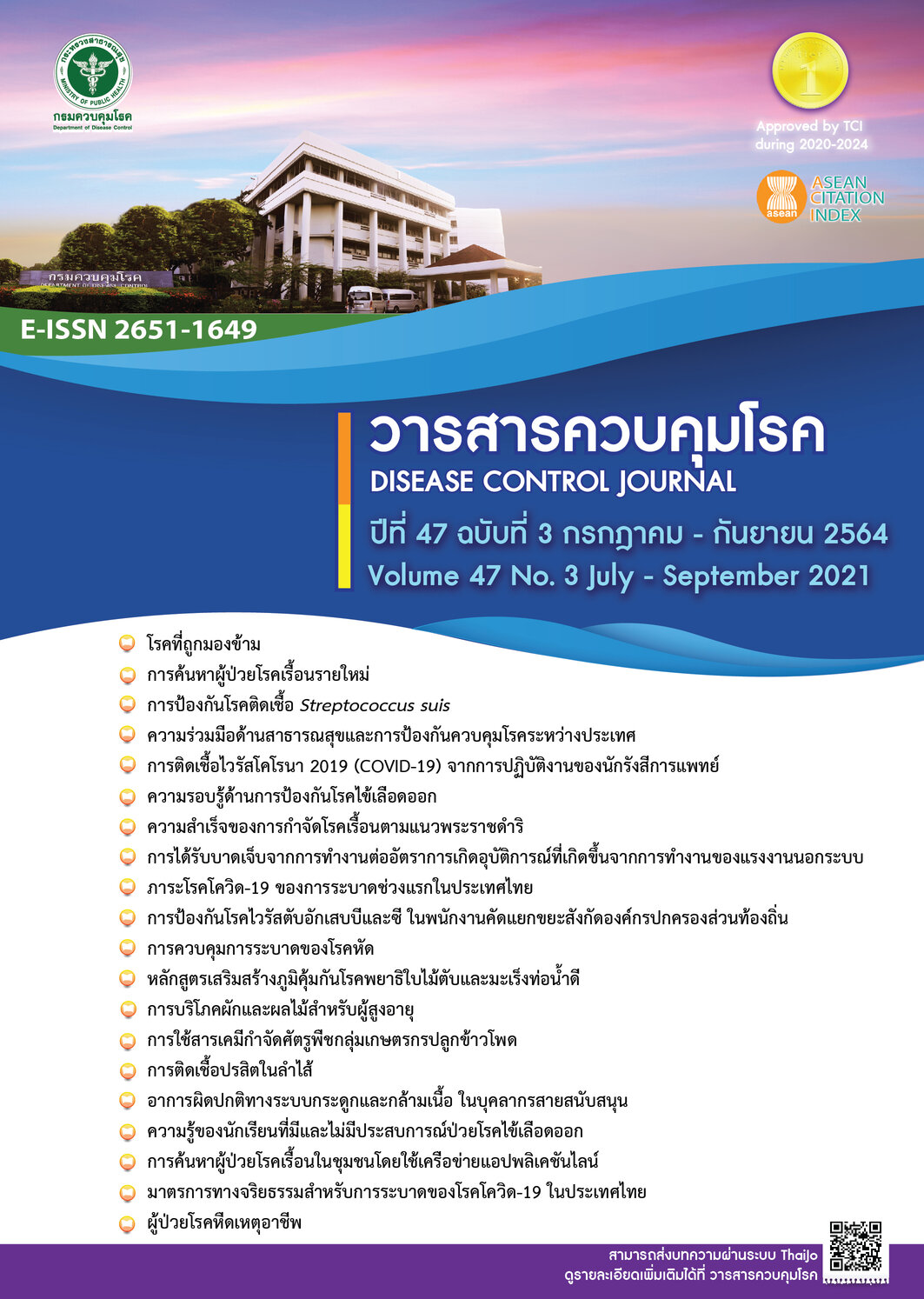Model Development for Hepatitis B and C Prevention among Waste Sorting Employees in Local Government Organization, Yasothon province
DOI:
https://doi.org/10.14456/dcj.2021.47Keywords:
HBV, HCV, waste sorting employeesAbstract
This study aimed to develop and assess the model of the hepatitis B virus [HBV] and hepatitis C virus [HCV] prevention systems among waste sorting employees in local government organization in Yasothon province. The action research was used to develop the model. The research had three stages: firstly, preparing and situation analysis, secondly, developing the model; and finally, operating and testing the developed model. There were 357 participants who were waste sorting employees. Data analysis was done by content analysis for qualitative data and descriptive statistics and inferential statistics for quantitative data. Study was conducted during June to April 2020. The results found that the participants were mainly male (90.1%), having previously had an accident while waste sorting (34.2%), having had sex without condoms (23.2%), having been stabbed by pointed object (21.6%), HBsAg positive (3.1%), anti-HCV positive (4.2%). The qualitative data found that HBV-HCV prevention and treatment were unclear for the operation in the past. Case management system and health literacy program has been developed to solve the problem. The system developed could help people living with HBV-HCV access to the health care (92.3%). Health literacy program was effective as participants knowledge and health behavior improved significantly (p-value<0.05). Following the program implementation, the number of new cases in intervention group (1/26, 1/26) was lower than control group (3/26, 4/26), but not statistically significant (p-value>0.05). The developed model had four components including: 1) Behavior surveillance, 2) Blood testing, 3) Case referral for treatment, and 4) Health literacy, which should be implemented using an integrated approach and active engagement by all local stakeholders.
Downloads
References
Perz JF, Armstrong GL, Farrington LA, Hutin YJF, Bell BP. The contributions of hepatitis B virus and hepatitis C virus infections to cirrhosis and primary liver cancer worldwide q. 2006;45:529–38.
Leroi C, Adam P, Khamduang W, Kawilapat S, Ngo-Giang-Huong N, Ongwandee S, et al. Prevalence of chronic hepatitis B virus infection in Thailand: a systematic review and meta-analysis. Int J Infect Dis [Internet]. 2016 [cited 2011 Jun 15]; 51:36–43. Available from: http://dx.doi.org/10.1016/j.ijid.2016.08.017
Committee for the Development of Viral Hepatitis Prevention and Control Plan, Ministry of Public Health. Thailand National Strategy on Viral Hepatitis Prevention and Control, 2017-2021. Nonthabuti: Viral Hepatitis Coordinating Center; 2016. (in Thai).”
Thai Association for the Study of the Liver. Thailand practice guideline for management of chronic hepatitis B and C 2015. Nonthaburi: Thai Association for the Study of the Liver; 2015. (in Thai)
Silarak K, Namwong T. An evaluation of hepatitis B viral surveillance, Yasothon province, Thailand, January 2014–December 2016.Weekly Epidemiological Surveillance Report. 2017;48(49):769-76. (in Thai)
Decharat S. Quality of life among garbage workers, Case study: Southern Thailand. Journal of Safety and Health. 2016;9(31):6-15. (in Thai)
World Health Organization (WHO). Global health sector strategy on viral hepatitis 2016–2021. Geneva: Switzerland; 2016.
Department of Disease Control (TH). Department of disease control joins hands with the department of local administration to support the eradication of hepatitis virus in Thailand [Internet]. 2021 [cited 2021 Apr 20]. Available from: https://ddc.moph.go.th/brc/news.php?news=11427&deptcode=brc (in Thai)
Kemmis S, Mc Taggart R. The action research planner. Victoria: Deakin University press. 1990.
Division Health Education (TH). Health education program for enhancing health literacy according to the 2 Sor. (Smoking and Alcohol drinking) principles in the prevention of hypertension, diabetes and cancer for working age. Nonthaburi: Health Education Division, Department of Health Service Support; 2018. (in Thai)
Kaeodumkoeng K, Thummakul D. Health literacy promoting in aging population. Journal of health science research. 2015;9(2):1-8. (in Thai)
World Health Organization (WHO). Why health literacy is important. [Internet]. 2019 [cited 2019 Feb 20]. Available from: https://www.euro.who.int/en/health-topics/disease-prevention/health-literacy/why-health-literacy-is-important.
Best JW. Research in education. New York: Prentice-Hall, Englewood Cliffs; 1977.
Sriamporn S, Vatanasapt V, Martin N, Sriplung H, Chindavijak K, Sontipong S, et al. Incidence of childhood cancer in Thailand 1988-1991. Paediatric and Perinatal Epidemiology. 1996;10(1):73-85. (in Thai)
Department of Disease Control (TH). Summary of the annual surveillance report 2016 [Internet]. 2016 [cited 10 Nov 2018]. Available from: http://boe.moph.go.th. (in Thai)
Proungvitaya T, Jantorn S, Suwannathada S, Homchampa P, Proungvitaya S. Incidence of hepatitis B and C virus in new cases of hepatocellular carcinoma patients attending at National cancer institute. J Med Tech Phy Ther. 2012;24(3):264-71.
Stormacq C, Wosinski J, Broucke SV. The effectiveness of health literacy interventions on health-related outcomes among socioeconomically disadvantaged adults living in the community: a systematic review protocol. JBI Database of Systematic Reviews & Implementation Reports. 2016;14(2):49-63.
Pannak P, Moonasart S, Kaewprom C. The Effectiveness of a program for health literacy development of the patients with uncontrolled type 2 diabetes at. NJPH. 2020;27(3):91-106.
Downloads
Published
How to Cite
Issue
Section
License
Articles published in the Disease Control Journal are considered as academic work, research or analysis of the personal opinion of the authors, not the opinion of the Thailand Department of Disease Control or editorial team. The authors must be responsible for their articles.






